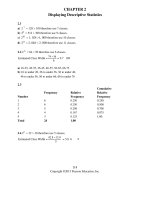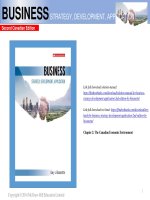Solution manual for business strategy development application 2nd edition by bissonette
Bạn đang xem bản rút gọn của tài liệu. Xem và tải ngay bản đầy đủ của tài liệu tại đây (925.66 KB, 46 trang )
BUSINESS STRATEGY, DEVELOPMENT, APPLICATION
Second Canadian Edition
Link full download solution manual:
/>Link full download test bank: />Chapter 2: The Canadian Economic Environment
Copyright © 2016 McGraw-Hill Education Limited
1
BUSINESS STRATEGY, DEVELOPMENT, APPLICATION
Second Canadian Edition
Learning Objectives
1. The ability to identify the major contributing factors that impact overall
economic development
2. Exposure to the core economic model that shapes Canada’s economic
growth and development
3. A base-level understanding of what constitutes economic activity and
how economies grow and contract
4. The ability to recognize trends that will influence the future composition
of economic development in Canada
5. Guidance on how managers use information on economic trends in
today’s marketplace to better manage their organizations and respond to
the competitive challenges confronting them
Copyright © 2016 McGraw-Hill Education Limited
2-2
BUSINESS STRATEGY, DEVELOPMENT, APPLICATION
Second Canadian Edition
Canada & Its Economic System
• Canada possesses one of the most fully developed and
diversified economic systems in the world.
• Abundance of natural resources, skilled labour, and
sophisticated technology-based.
• Canada’s economy has moved from being primarily
agricultural to a diversified system.
• Productivity gains, strong business investment, technological
innovation, moderate wage increases, and a favourable currency
exchange rate create a resilient and competitive Canadian
economy.
Copyright © 2016 McGraw-Hill Education Limited
2-3
BUSINESS STRATEGY, DEVELOPMENT, APPLICATION
Second Canadian Edition
Canada & Its Economic System
• Products driving current trade performance
include oil and gas, canola, wheat, gold, nickel,
potash, sulfur, telecommunications, aerospace,
forestry-related, and automotive sector products.
• Canada is a member of the G7/8
• Trading relationship with the United States.
Copyright © 2016 McGraw-Hill Education Limited
2-4
BUSINESS STRATEGY, DEVELOPMENT, APPLICATION
Second Canadian Edition
Key Economic Influencers
• Contributing factors to Canadian economic development
include:
A stable political system
Necessary infrastructure - roads, ports, utility systems, educated
workforce, technology-based business management systems
Manageable debt levels
Efficient / techno-savvy banking system
Well-managed inflation levels
Strong monetary policies and a central bank (Bank of Canada)
Strong natural resource base
• Comparative Advantage
Copyright © 2016 McGraw-Hill Education Limited
2-5
BUSINESS STRATEGY, DEVELOPMENT, APPLICATION
Second Canadian Edition
Contributing Factors to Economic
Development
Copyright © 2016 McGraw-Hill Education Limited
2-6
BUSINESS STRATEGY, DEVELOPMENT, APPLICATION
Second Canadian Edition
Foreign Direct Investment (FDI)
•
Foreign direct investment
FDI into Canada has been increasing; it topped $686.3
Billion in 2013
Just over half of FDI flowing into Canada comes from the
US
Canada is viewed as a safe and lucrative place to do
business
Both Europe and Asia/Oceania are active investors in
Canada
Copyright © 2016 McGraw-Hill Education Limited
2-7
BUSINESS STRATEGY, DEVELOPMENT, APPLICATION
Second Canadian Edition
The Underlying Economic Model
•
3 Fundamental Market Composition Principles:
1. The Law of Supply and Demand
2. Allowance for private ownership, entrepreneurship, and
wealth creation
3. Extent of government in influencing economic activity
and direction
•
A balanced relationship needs to exist between the three
fundamental market composition principles in order for an
economic system to develop and grow.
Copyright © 2016 McGraw-Hill Education Limited
2-8
BUSINESS STRATEGY, DEVELOPMENT, APPLICATION
Second Canadian Edition
Law of Supply and Demand
• Demand
Inelastic demand
Elastic demand
• Supply
• Price Equilibrium
Copyright © 2016 McGraw-Hill Education Limited
2-9
BUSINESS STRATEGY, DEVELOPMENT, APPLICATION
Second Canadian Edition
Allowance for Private Ownership,
Entrepreneurship, and Wealth Creation
• Private Enterprise includes:
Personal Ownership
Entrepreneurship
Wealth Creation
• Some economies like Canada and the US fully support these
•
concepts in a climate of risk versus return.
Developing economies such as China and India are allowing
greater access to these capitalistic principles, while others like
North Korea, are not.
Copyright © 2016 McGraw-Hill Education Limited
2-10
BUSINESS STRATEGY, DEVELOPMENT, APPLICATION
Second Canadian Edition
Government Involvement in Influencing
Economic Activity and Direction
• Government:
•
•
Customer, regulator, manager, taxation agent, economic
stimulation agent, and competitor.
Open system - adheres to the principles of economic freedom: the
law of supply and demand, full and open access to the principles of
private ownership, entrepreneurship, and wealth creation, and an
absence of regulation on the part of the government.
Controlled system - the fundamentals of the law of supply and
demand, private ownership, entrepreneurship, and wealth creation are
largely restricted or absent, and the government fully controls the
economic direction and activity.
Copyright © 2016 McGraw-Hill Education Limited
2-11
BUSINESS STRATEGY, DEVELOPMENT, APPLICATION
Second Canadian Edition
Canada: A Mixed Economic System
•
The Canadian economy allows the law of supply and demand to
significantly influence the market.
•
The principles of private ownership, entrepreneurship, wealth
creation and their corresponding risk and return opportunities are
present and supported.
•
The Canadian government is an active participant in the economy
but attempts to manage economic activity through a
cooperative/competitive model using its powers of taxation,
regulation, national debt targets, provincial transfers, and
monetary policy control.
Copyright © 2016 McGraw-Hill Education Limited
2-12
BUSINESS STRATEGY, DEVELOPMENT, APPLICATION
Second Canadian Edition
Canada: A Mixed Economic System
Copyright © 2016 McGraw-Hill Education Limited
2-13
BUSINESS STRATEGY, DEVELOPMENT, APPLICATION
Second Canadian Edition
Business in Action:
Role of the Bank of Canada
•
•
•
•
Canada’s central bank
Created in 1934; became a Crown corporation in 1938
Develop and manage the monetary policies and financial systems
Has the following core areas of responsibility:
Managing inflation and currency supply
Developing and managing financial systems and safeguards
Providing fund management services to chartered banks
• Interest rate adjustment controls inflation
Copyright © 2016 McGraw-Hill Education Limited
2-14
BUSINESS STRATEGY, DEVELOPMENT, APPLICATION
Second Canadian Edition
The Economy in Simple Terms
Four fundamental Factors:
1.
2.
3.
4.
Expenditures – purchases made in support of daily economic
activity
Savings – dollars set aside to support economic activity and
wealth creation in/for the future
Capital Asset Investments – investments made today to expand
productivity and overall economic capacity
Credit – the borrowing of dollars to support expenditures or
investments being made
Economic Activity = Expenditures + Savings + Investment + Credit
Copyright © 2016 McGraw-Hill Education Limited
2-15
BUSINESS STRATEGY, DEVELOPMENT, APPLICATION
Second Canadian Edition
The Economic Growth Cycle
• Gross Domestic Product (GDP) - market value of all goods and
services a nation produces domestically over a year.
• GDP includes all the economic activity including:
•
Goods and services produced and purchased domestically
for consumption
Business investments within the economy
Goods produced for export purposes
Government spending
Recession – two or more consecutive quarters of decline in GD{
Copyright © 2016 McGraw-Hill Education Limited
2-16
BUSINESS STRATEGY, DEVELOPMENT, APPLICATION
Second Canadian Edition
Canada’s GDP Growth
Copyright © 2016 McGraw-Hill Education Limited
2-17
BUSINESS STRATEGY, DEVELOPMENT, APPLICATION
Second Canadian Edition
Key Economic Drivers
• Varies from country to country:
For China, the current key economic driver is the production of
•
•
•
goods and services and the underlying capital investments.
For the US, it is consumer spending; the US is one of the leading
purchasers of goods and services.
The US economy is $17 Trillion (2014 estimate) – the largest in
the world and is considered to be the engine that drives the global
economy.
60% of GDP activity in Canada is driven by consumer spending;
79% of Canada’s exports go to the US.
Other activities that influence Canada’s GDP movement include
natural resources, technology, and energy production.
Copyright © 2016 McGraw-Hill Education Limited
2-18
BUSINESS STRATEGY, DEVELOPMENT, APPLICATION
Second Canadian Edition
Economic Growth Cycle, North
America: Economic Expansion
Copyright © 2016 McGraw-Hill Education Limited
2-19
BUSINESS STRATEGY, DEVELOPMENT, APPLICATION
Second Canadian Edition
The Canadian Banking System
• The World Economic Forum, annually identifies Canada as the
most sound banking system in the world (2009-2014).
Best-managed and well-capitalized banking operations.
Well-develop and organized regulatory system
Governed by the Bank Act
A strong track record for risk assessment and control, and a
stable and secure operational environment
• Chartered Banks are financial institutions regulated under the
Canada Bank Act.
Copyright © 2016 McGraw-Hill Education Limited
2-20
BUSINESS STRATEGY, DEVELOPMENT, APPLICATION
Second Canadian Edition
Managing the Movement in the Economy
• Economic growth needs to be managed in a way that
stimulates investment yet maintains control of inflation
and other inefficient economic influencers.
• Inflation - A rise in the level of prices of goods and
services within an economy over a period of time.
• Growth that is taking place needs to be real growth not
masked by inflation.
Copyright © 2016 McGraw-Hill Education Limited
2-21
BUSINESS STRATEGY, DEVELOPMENT, APPLICATION
Second Canadian Edition
Managing the Movement in the Economy
• Given the geographic distribution of Canada’s economic
clusters, regional disparity exists in growth rates and
economic potential.
• Alberta, Saskatchewan, BC, and Newfoundland/Labrador have
experienced tremendous growth due to the increasing demand
for natural resources, agricultural based products, and energy.
• Growth needs to be stimulated in Central and Eastern Canada
without compromising the growth rates of the Western
provinces.
Copyright © 2016 McGraw-Hill Education Limited
2-22
BUSINESS STRATEGY, DEVELOPMENT, APPLICATION
Second Canadian Edition
Trends Impacting the Canadian Market
•
•
•
•
•
•
•
•
•
•
•
Consumer Debt Loads
Inflation
Geographic Clustering & Economic Imbalance
Currency Exchange Rate Impact
Branch Market Impact: Purchasing Power Parity & Takeovers
Sustainability and Green Initiatives
Aging Workforce, Immigration, and Multiculturalism
Long-Term Competitiveness
Small Business Emphasis:
Globalization & potential geopolitical instability
Threat of cyber attacks
Copyright © 2016 McGraw-Hill Education Limited
2-23
BUSINESS STRATEGY, DEVELOPMENT, APPLICATION
Second Canadian Edition
Managing in Challenging Times
• 3 Fundamental Questions:
1.
What are the general indicators saying about the current
economy and the relationships among the key variables
governing our mixed economic system?
2.
What broad-level changes (political, economic, social,
technological, environmental, and legal) are occurring which
might directly impact future growth and market position?
3.
What specific current competitive actions and market forces
may disrupt the way in which business is done within an
organization’s particular market sector?
Copyright © 2016 McGraw-Hill Education Limited
2-24
BUSINESS STRATEGY, DEVELOPMENT, APPLICATION
Second Canadian Edition
Primary Economic Indicators
•
•
•
•
•
•
•
•
•
•
•
Unemployment rate
Inflation Rate
Consumer Price Index (CPI)
New Housing Starts
Manufacturing Inventory
Consumer Confidence Index
Price per Barrel of Crude Oil
Stock Market Indexes (TSX, S&P 500, Dow Jones)
Currency Exchange Rate
Monthly Retail Sales
Industry-Specific Indexes
Copyright © 2016 McGraw-Hill Education Limited
2-25









